You’re not Punk, and I’m Telling Everyone.
With the release of Order & Chaos, Anarchs gained a lot of exciting new tools: Wanton Destruction, Silverware, Eater, Steelskin I’ve Had Worse, and three identities, two of which look like they could have serious potential. That’s not even mentioning the new viruses, which compete for space in the already-tight Noise decks that have been on the up-and-up as Cache, Earthrise Hotel, and Inject were being released.

The most obvious strategy being pushed on us centers around Eater. In conjunction with old favorites like Account Siphon, Vamp, and Keyhole, Eater’s drawback can be largely mitigated. Additionally, Anarchs gained a suite of “silverware” run events, Forked, Knifed, and Spooned, so that Eater can clear a server of ICE so that you can come back and access cards on a later run. Wanton Destruction and Shards round out these new Eater decks, which all combine to put enough pressure on central servers with Eater alone that you don’t need to worry about including a full breaker suite to back it up.
The two new identities that work best with Eater, Valencia and Maxx, are both being experimented with extensively as of the writing of this article. Maxx seems to be the identity of choice for Eater decks for the time being, as she can set up Eater quickly and mill Account Siphons to recur, putting immense HQ pressure on right off the bat, with an AI breaker suite that ensures you can get in provided you have access to enough cash. The Wanton-Siphon HQ assault is backed up by Keyhole, which can end the game extremely quickly if the Corporation can’t mount a sizable R&D defense while continuing to play around Account Siphon. A few people have found fast success with this sort of strategy, taking down Store Championships and GNK tournaments almost immediately after O&C hit the shelves:
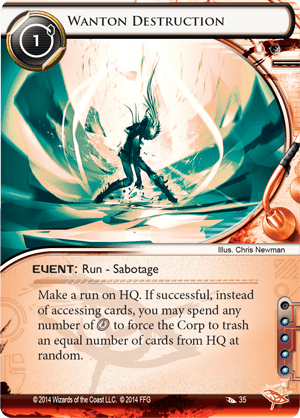
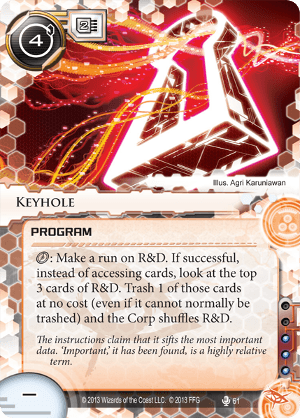
The Gamers Den Store Championship, Cambridge MN
21 players, 5 rounds, cut to top 8 double elim
Winner: Jeff Schoenberg
MaxX Doesn’t Care (45 cards)
MaxX: Maximum Punk Rock
Event (27)
2x Account Siphon
3x Day Job
3x Déjà Vu
1x Forked
3x I’ve Had Worse
2x Inject
2x Knifed
1x Levy AR Lab Access
2x Retrieval Run
1x Singularity
2x Spooned
3x Sure Gamble
2x Wanton Destruction
Hardware (1)
1x Box-E
Resource (7)
1x Hades Shard
3x Liberated Account
3x Same Old Thing
Icebreaker (8)
3x Eater
2x Femme Fatale
3x Knight
Program (2)
2x Keyhole
Chimera Store Championship, Nottingham, UK
21 players, 5 rounds, cut to top 8 double elim
Winner: Marek Nerkiewicz
Chaaarge (45 cards)
MaxX: Maximum Punk Rock
Event (25)
2 Account Siphon
3 Day Job
3 Deja Vu
1 Forked
3 I’ve Had Worse
2 Knifed
1 Levy AR Lab Access
2 Retrieval Run
1 Singularity
2 Spooned
3 Sure Gamble
2 Wanton Destruction
Resource (11)
1 Hades Shard
3 Joshua B
3 Liberated Account
3 Same Old Thing
1 Utopia Shard
Icebreaker (7)
3 Eater
2 Femme Fatale
2 Knight
Program (2)
2 Keyhole
Both of these decks seek to use a breaker suite of Eater, Knight, and Femme Fatale in conjunction with Keyhole and powerful run events, and were successful in doing so. Maxxs ability provides a constant flow of pressure for this deck, so that once it lands a single Account Siphon, it snowballs its way to victory, tacking advantage of the Corporations stagnating early game by sending their boards, their hand, and their deck to the trash and coming back to pick up the pieces after it’s ripe with agendas.
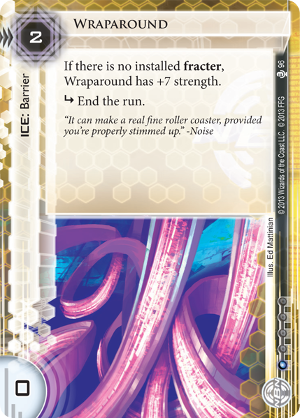
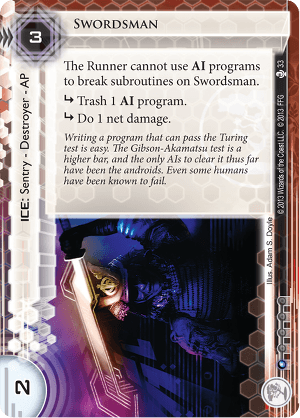
As powerful as this deck is, it has some flaws. It can have trouble getting into remote servers, so it relies on the extremely quick setup time of having a 1-breaker rig to prevent the corporation, regardless of what deck they might be playing, from rushing out agendas behind one or two pieces of ICE. It has a somewhat weak economy, and can be taxed out of central servers if it can’t land a big Siphon. It’s vulnerable to a few not-unreasonable hate cards like Wraparound, Swordsman, and Crisium Grid. That’s the price you be for playing this sort of combo deck: it’s a lot easier to disrupt than a deck that just plays economy, conventional breakers, and some multi-access, such as Andy Sucker or Prepaid Kate.
Funny thing about Maxx is, her ability is actually a lot more powerful than either Andy’s or Kate’s. Maxx not only will draw you upwards of 10-15 free cards every game, but the self-mill provides access to milled cards through recursion. This is hugely important because Anarch has no tutoring in-faction besides Djinn, but it has access to and a lot of synergy with recursion. In conjunction with Maxx’s ability, Deja Vu turns into an incredibly versatile card, Same Old Thing acts as an event tutor, and splashed Clone Chips work as instant-speed Special Orders in addition to being able to recur Parasites, Imps, or Mediums right when you need them.
Maxx brings newfound consistency to a faction that previously had to play many redundant copies of cards to see them on a regular basis, while at the same time delivering an economic boost that surpasses any runner that has been printed to date. This incredibly potent combination can support a much more robust, dynamic game plan than Anatomy of Anarchy Siphon spam or Noise can. Maxx gives Anarch the ability to play more like a Shaper if she has the right tools available to her.
So I went and built a deck: A Maxx deck that foregoes the AI breakers, tag-me shenanigans, and virus spam elements that defined the Anarch faction up to this point in favor of good, old-fashioned breakers and money.
All Things Fun Store Championship, New Jersey
17 Players, 4 rounds cut to top 4
Winner: Dan D’Argenio
Reg-ass Maxx (45 cards)
Maxx: Maximum Punk Rock
Event (15)
2 Deja Vu
3 I’ve Had Worse
2 Knifed
1 Legwork
1 Levy AR Lab Access
1 Lucky Find
1 Queen’s Gambit
1 Stimhack
3 Sure Gamble
Hardware (5)
3 Clone Chip
2 Grimoire
Resource (10)
3 Daily Casts
3 Kati Jones
2 Liberated Account
2 Same Old Thing
Icebreaker (6)
2 Corroder
2 Mimic
1 Yog.0
1 ZU.13 Key Master
Program (9)
1 D4v1d
2 Datasucker
2 Imp
1 Medium
3 Parasite
Maxx’s ability’s biggest drawback is that it naturally puts her on a clock; after a certain number of turns, your deck is going to run out of cards, and you’re going to have to make do with what you have at that point. This isn’t just a problem if you’re playing against Jinteki PE. If you happen to mill a lot of your programs, you might not be able to recur everything you need going into a long game. Furthermore, if you’re playing against a Corp that slows the game down like Jinteki: RP or an IT Department HB deck, you suffer economically when you fail to make use of your ID ability and need to click for a lot of credits because all your economy is in the Heap. For this reason, despite the heavy 3-influence cost, 1 Levy AR Lab Access is almost mandatory for any Maxx deck that doesn’t have way too many cards in it.
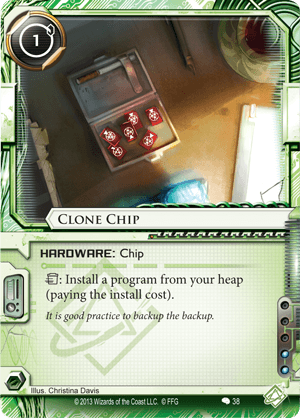
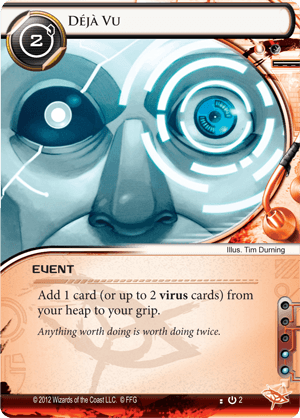

Of course, since you want to make sure you have access to your Levy and take advantage of your self-mill, Maxx is going to want recursion. I went with 3 Clone Chip, 2 Deja Vu, and 2 Same Old Thing. Same Old is largely there for your Levy, but I made sure to go out of my way to include some more reasonable targets so that when you draw both of them or your Levy or see them on the second time through your deck, it’s not a useless card despite your lack of Account Siphon. 2 Deja Vu give you access to your breakers or Levy if you need it to, but shines best when brining back some combination of two viruses. Because it can take some time to get full value out of it, I went with only 2, though 3 is certainly reasonable if you can find the space. The 3 Clone Chips are probably the most important piece of this deck. Being able to recur your Parasites at instant speed so that you don’t have to deal with pesky subroutines is as good as ever, but additionally, when you use it to find your milled breakers, it provides functional tutoring at a rate better than the ubiquitous Self-Modifying Codes and Special Orders, costing you only $1 more than if you installed the card from your Grip. You can also include Scavenge in this sort of deck as an additional Clone Chip that you can not only use to recur programs, but also to reset a D4v1d or Imp once it runs out of counters.
The only additional draw I have included is 3 I’ve Had Worse. Inject is a great card for Maxx, and it’s possible that I am making a mistake by not including it, but I couldn’t find any room and found that my ability provided plenty of extra cards. IHW does double duty, protecting you from flatlines when it’s not simply drawing you 3 cards at a reasonable price. If you haven’t included 3 IHW in your Anarch decks, it’s time to start: there is almost no downside to playing this card. Against decks like Jinteki: RP that deal you damage as a tax, you can often get it to trigger for free by running through a Pup or Komainu, making it the single most cost effective card draw event in the game.
Deciding on an economy package for this new type of Anarch deck is a difficult thing to do, and it is still largely a work in progress, but I think I have stumbled on one that is, if not optimal, functional. With our influence largely tied up in recursion, we can’t use 3 Lucky Finds or Cache/Pawnshop or Siphon Spam to keep our coffers full, so we’re going to have to look in faction.

3 Sure Gamble and 3 Daily Casts are easy choices: $4 or $5 is totally reasonable for a single click, especially when you didn’t have to spend a click to draw the card in the first place, but they aren’t nearly enough on their own. Liberated Accounts is a great economy card that has been stifled by Anarchs propensity to be too poor to play it in the first place, but this deck isn’t like the old Anarch decks, so including 2 is totally reasonable. Queens Gambit is like the bastard Anarch child of Bank Job and Lucky Find, but for 0 influence. As long as your opponent is shoving things in remote servers, you will be able to fire it eventually for a huge payoff. Because it’s not always reliable and some opponents can and will play around it, I am only including one, but a second is totally fine if you like to live life on the edge. 1 Lucky Find rounds out the burst econ, mostly because I can’t think what to do with 2 extra influence aside from play Scavenge, and I like having a lot of money in my decks.
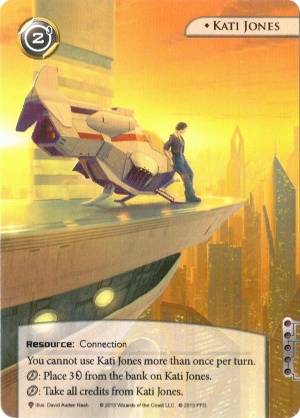
Kati Jones rounds out the economy. She might not be the flashiest economy engine anymore, but she gets incredible value against slower decks, and is almost never worse than clicking for credits, even if you have to take money off of her frequently. Because you don’t necessarily want to be spending your clicks on drawing cards like a normal runner, Kati gives you something to do with your time when the running isn’t particularly good, and she can power your rig pretty effectively on her own if you run out of cards. Including 3 Kati Jones isn’t particularly common anymore because additional copies don’t help you, but you’re pretty likely to mill copies of her, and getting her on line as soon as possible is pretty important for this deck. I left Day Job out of this deck because of Kati Jones: it isn’t a bad card, but if you have to give up your turn’s use of Kati to play it, it’s much worse.
As I said before, Same Old Thing wants something more than Levy to justify its inclusion. If you’re drawing a ton of extra cards but tons of them are devoted entirely to mitigating your IDs drawback, your ability simply isn’t as strong as it otherwise would have been. SOT for conventional economy doesn’t make a lot of sense outside of Prepaid Kate, as the two extra clicks can make your Sure Gambles look like click-for-credits. Stimhack, on the other hand, is a totally reasonable target. It’s one of the most powerful economy cards in the game, and including it allows you to make superpowered runs on Ash servers, trash SanSans, and recur whatever you want with Clone Chips during your run if you have some money left over. 1 Legwork rounds out the Same Old Thing package. I gave it the nod over Wanton Destruction and Nerve Agent as HQ multi-access not just because I believe it to be a superior card on its own, but because it is such a fantastic Same Old target. The extra clicks required by SOT make Wanton pretty terrible to recur, but Legwork doesn’t need extra clicks, and is so valuable at certain points in the game that the extra clicks to play it out of the Heap are well worth it if you can get your timing right.
Knifed is the final inclusion for Order & Chaos. I chose Knifed over Forked and Spooned for a few reasons. First and foremost, Eli 1.0 is the most splashed and possibly the most efficient piece of taxing ICE in the game. Knifed can destroy an Eli without any breakers in play, setting the corp back significantly for the low cost of $1. Even if your opponent doesn’t have an Eli on the board, we are entering into a new era of taxing Barriers that you don’t want to have to break with Corroder more than once, or ever. Galahad is starting to see a lot of play in all sorts of decks and Hive is in almost every Blue Sun deck for good reason, and Knifed ensures you only have to deal with all of those subs once. Additionally, it allows your D4v1d to destroy Curtain Walls even without Oversight AI attached to them. At $1, it’s also a pretty reasonable Same Old target, especially if you’re spending your turn to blow up a lone Eli protecting R&D. If you’re having a lot of trouble with Lotus Fields or Tollbooths, Spooned could be subbed in for one of the Knifes pretty easily, but I would avoid Forked for the time being, as most Sentries are a pain to facecheck, a pain to re-run, and either relatively easy to kill with Parasite or break with Mimic, (and Architect can’t even be destroyed anyway).
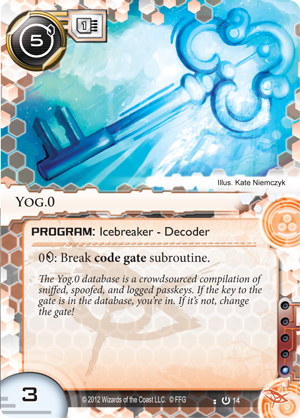
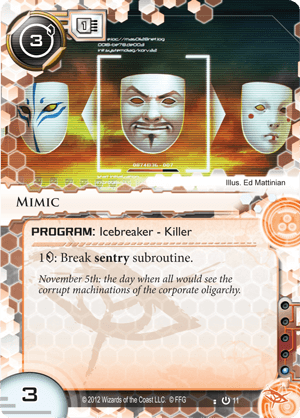

The breaker suite is pretty self-explanatory. Corroder, Mimic, and Yog.0 have been the suite of choice for Criminals since the game’s inception, and in Anarch, we don’t even need influence for them. We can even afford to play some redundant copies to make it more likely that we see them quickly and have to worry less about losing them to Destroyers or damage. Zu.13 Key Master is included instead of the 2nd Yog because of Lotus Field, which demands an answer. Knight is an influence-free alternative, but a Lotus Field out of Blue Sun tends to make Knight look silly, and Zu.13 is a completely reasonable Decoder for a deck like this anyway. 1 D4v1d is a great complement to the largely fixed-strength breaker suite, allowing you to break things like Tollbooth, Curtain Wall, Wall of Thorns, Archer, and the new “space” ICE without breaking your bank or charging up on Datasuckers. Being able to stifle the OAI-Curtain combo out of Blue Sun is a huge deal, of course, so if you have a lot of BS in your meta you should think about making room for a second copy of D4v1d.
Datasucker and Parasite are natural additions to this sort of deck. One of the biggest advantages to playing an Anarch deck like this one or Noise is that you have Parasites pouring out of your asshole. Between Deja Vu, which can recur 2 Parasites if necessary, and Clone Chip, which can combo with Sucker/Parasite to destroy ICE before you even have to break it, you have one of the most potent ICE destruction packages available without much effort at all. I decided only to play 2 Datasucker because your deck doesn’t rely on it as much as Criminal decks or Atman decks, you only want one of them anyway, and it’s easy enough to get back with a Deja Vu if you need it.
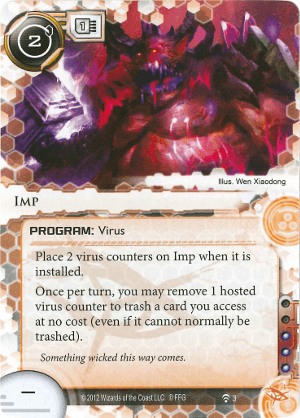
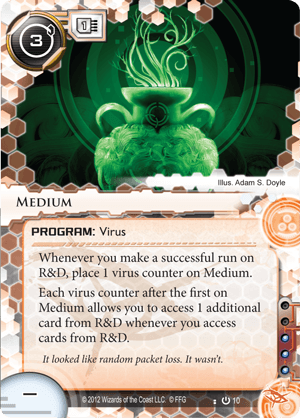
Imp and Medium are the two biggest reasons to be in Anarch. Most of Anarch’s best cards are low-enough influence and tutorable for Criminals and Shapers that Anarch IDs were neglected while the other two factions used their programs. At 3 influence a pop, Medium and Imp are two powerhouses that give Anarchs a leg up on the competition. Imp wears many pants, in this deck, not only for trashing expensive assets and upgrades the corp leaves on the board, but providing additional central server pressure, inducing the Corp to rez their ICE so we can later tear it down, or else denying them valuable whatever-the-fucks while we fail to hit agendas on our accesses. Medium has proven itself to be one of the best ways to pressure R&D in the game, outshining R&D interface and the Maker’s Eye against dedicated fast advance decks like NEH, more and more often getting the nod in Criminal decks despite the influence cost. It also can turn a lack of ICE on R&D into a long-term problem that can’t be solved as simply as by patching the hole, as it will already have accumulated some of the most valuable virus tokens in the game and will often demand a clear as well. I chose to only include one despite the fact that it often functions as your finishing blow because Maxx will mill it eventually, and both Clone Chip and Deja Vu do a great job of getting it out when you need it, (usually only after you have your console in play).
Grimoire is given the nod as the console mostly because of the 1 Medium, but 2 extra memory for $3 is no joke, and neither are extra Imp counters and supercharged Parasites. It might not give you the incredible value you can get out of it in Noise, but $3 for an extra R&D access is good on its own, and being able to quickly destroy ICE with Parasite can make the corp slow down a lot, having to overprotect servers or clear Datasucker counters just so they don’t find themselves getting their servers dismantled and Imped when they go to score an agenda. The other potential choices, Vigil and Spinal Modem, are probably okay as well, but I find that Grimoire has enough synergy with your 8 viruses to justify it here. I actually started with Spinal Modem, but found that I was destroying ICE more often than I was breaking it anyway, and thus switched over to Grimoire.
On playing more than 45 cards in Maxx
I think that there might be some merit to playing more than 45 cards in your Maxx deck, but honestly, I can’t be sure. Perhaps this decklist would be better at 48 card with 3 Inject, or maybe you just want some extra cards to fit another Deja Vu and another D4v1d. My inclination is to stick to 45. Some people have argued 47 makes sense so that you can have 42 cards left after your initial hand draw, which is a multiple of 3. This logic doesn’t make a lot of sense because you will want to click to draw a few times in a game anyway, but that doesn’t mean 47 can’t make sense for other reasons. It’s hard to justify any specific number with hard math other than 45, so I’m going to stick to that number. The main reason is that you don’t actually have access to a lot of great economy in Anarch, so playing the minimum allows you to increase your chances of seeing your Sure Gambles, Daily Casts, and Kati Jones. Most of the ‘bad’ hands that come out of this deck are bad because they don’t have enough money, and going over 45 to add non-economy cards is going to make this even more of a problem, (the reason why I mentioned Inject specifically as the 46th-48th cards is that it helps this problem more than it hurts).
Strategy and Matchups
Reg-Ass Maxx functions much in the same way as Prepaid Kate does, the main differences being that you have a worse economy engine but better programs. Taking advantage of your Viruses is the key to why this deck can be Tier 1 while still relying on Tier 2 economy cards like Liberated Accounts. Parasite is the ultimate workhorse: your goal should be to remove ICE whenever possible rather than break it, because your relative lack of multi-access and powerful run events like Account Siphon makes paying for single accesses on centrals unpalatable.
Imp is very important to this strategy. If you have an Imp in play with counters, the corp will be forced to rez the ICE on their centrals to stop you from Imping their hand or R&D and removing the nonagenda cards, many of which would be otherwise helpful to their game plan. Once you induce some rezzes, you can Parasite or Knife their ICE as you set up, slowing the game down and taking full advantage of your once-per-turn abilities on your ID and Kati Jones, and giving you time to put together your breaker suite.
Going into the late game, you can start to think about multi-accessing. Legwork at an opportune time is as powerful as ever, but your 1 Medium is going to do a whole lot to close out games. If you can keep them at 2 or fewer R&D ICE, eventually you will be able to assemble something like Grimoire, Parasite, Medium, and take a turn to pilfer R&D. At that point, the corp will be put in the awkward position of having to re-ICE R&D and THEN clear viruses on the next turn, which is a huge slowdown for them that leaves the potential for you to Parasite their new ICE and continue from there, especially if they ever turn their attention away from R&D to score.
It’s important never to lose sight of your economy in this deck. Most of your economy is either expensive to play, (Liberated, Gamble), or slow to get going, (Daily Casts, Kati Jones), so you should always have a plan on the horizon for how you’re going to get more money in the future. That usually involves not spending all of your money so that you can play your Liberated Accounts for a quick boost or install Daily Casts without having to wait around clicking for credits to do anything else. It’s not the end of the world if you have to click for credits a few times, but the last position you want to find yourself in is having $0 with a Liberated and a Daily Casts in hand, so be very careful not to go broke trashing things like Daily Business Show. Instead, draw some cards and find some money, and get up to $7-10 so that if you do have to spend some money, you won’t be so poor after the fact. using Kati every turn goes a long way, so try to get full value out of her unless using her is going to prevent you from playing more powerful economy cards in your hand.
Don’t forget to look at the cards in your Heap not just as a toolbox, but as a message, telling you what’s in the rest of your deck. You almost always want to have 3 cards left in your deck going into that last turn so you get the best value from your ability, but whether you want to draw 4 cards or 1 card when you have 13 cards left in your deck is a decision you’re going to have to make every game. If the cards left in your deck are the ones you want to draw, click to draw more often. If they’re not very good, just draw until you have a multiple of 3 left in your deck and stop, or even consider Levying early.
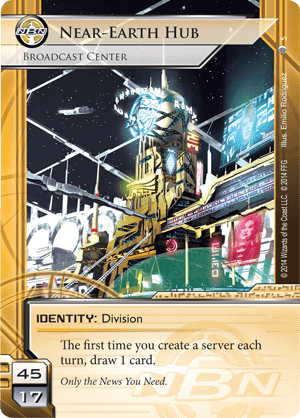
Near Earth Hub AstroBiotics is a tricky matchup, but it is very much winnable, even if it isn’t necessarily favorable. Being able to Imp their expensive assets is a pretty big advantage for Anarch, and Medium locking them is one of the best ways for any runner to close the game out against fast advance. Install your Mimic if possible before facechecking, especially R&D, as you don’t want to let them fire off Architect, (though you can sometimes run through it later if you’re gaining Medium counters). Knife their Elis, Parasite or Yog through their Quandaries and Popup Windows, and use Corroder to deal with Wraparound. Kati Jones is at her worst in this matchup, but she’s still worth installing if you find her early enough. You will probably not be able to get more than $6 on her at a time, but in the long run, it’s still better than clicking for credits. Use your judgement on trashing PADs and unrezzed SanSans. If they’re poor and you have reasonable HQ access, SanSan might not be top priority, and PAD is usually only worth trashing at the beginning stages of the game. Because of Imp they are unlikely to try to sneak naked agendas past you, but if you have any sort of lead, don’t let them get away with any funny business.
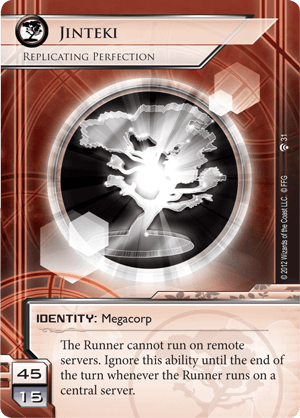
Jinteki RP is a slog but a matchup I feel you have a slight advantage in. Medium is a lot more powerful than other R&D multi access against RP because you can potentially see The Future Perfect multiple times to give you a better shot at stealing the most important agenda. Killing their economy is important: You have drip economy built into your ID, so if you can get into a long game where you’re successfully using your ability but they have no Sundew, you can maintain parity or even pull ahead. Parasite does a lot of work against their Sentries, but breaking them can get very expensive, so try to assemble Clone Chip + Datasucker so you don’t have to deal with Tsurugi or Komainu subs. Pup only costs $1, but it’s still a great Parasite target. Don’t forget that I’ve Had Worse can trigger off Pup and Komainu, so think about ways you can extract full value from it by allowing them to deal you damage when your hand contains IHW and some otherwise lackluster cards. Unlike in most matchups, Parasiting their remote ICE is a totally fine thing to do. As long as they can’t score their Nisei Mk II, you’re buying yourself loads of extra time and forcing Agendas to pile up in HQ, forcing Jackson usages if the Corp doesn’t want to become vulnerable to your Legwork.
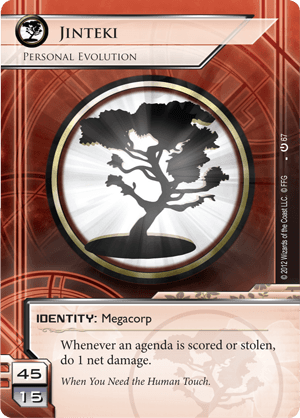
Jinteki PE vs Maxx is a strange one. Your extra card every turn goes a long way towards keeping you alive, as does I’ve Had Worse, but you do have a very finite number of hit points. Be very wary of losing everything to a Chronos Project: don’t neglect to check their unadvanced remotes. In the end, you’re actually pretty resilient to flatline as long as you don’t run out of cards. One way you can get around your drawback is to simply click to draw more often: If you run into a Snare or Psychic Field and then spend the rest of your turn drawing up, it isn’t nearly as bad as if you were a Criminal doing the same thing because a lot of those cards would have gotten milled anyway. Parasite recursion is quite good against PE ICE, so try to go that route rather than installing your breakers when possible.
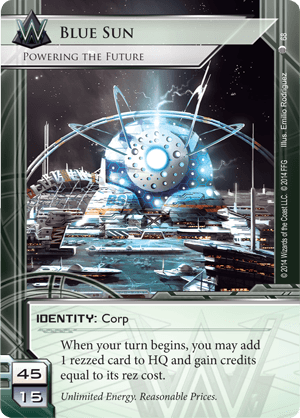
Blue Sun can be tough: Your Parasite recursion plan can be snuffed by their ID ability. To get around this, try to accumulate Datasucker tokens so you can kill ICE with Parasite the turn you install it. If you can keep them off Adonis Campaign and destroy their ICE, they will have a hard time keeping up economically. D4v1d is hugely important here, so if you see a ton of BS, you probably want a second copy, but remember, even if you miss the chance to kill Curtain Wall with OAI on it, you still can install your D4v1d later and Knife it away. Prioritize Zu over Yog, even if you see some Datapikes: they can get a refund for their ICE if it becomes worthless, and they’re relatively likely to play Lotus Field. Your only Scorch defense is I’ve Had Worse, which requires a little bit of luck and a 5 cards hand. Try to keep 5 cards any time you’re vulnerable to SEA Scorch: even if you don’t have IHW, they will have to assume you do. If they are on the Scorch plan, try to Imp their pieces out of your hand to give yourself breathing room. Medium can be exceptionally powerful if you can keep them poor-ish, as you can take the opportunity to force rezzes on their remote when they go to score and then follow up by taking the fight to their R&D.

Grails can be a huge problem to break, but in the end, your trashing potential is going to help a lot playing against anyone, be it IT department, NEH, RP, or Foundry using the Grail ICE. They need a critical mass of Grails in play and in hand to make their ICE any good, so trashing it is a great solution. Getting into their hand to Imp and removing ICE from the board will usually leave them with too little Grail ICE to really wreck you. If you see grails, think about keeping your program count low so that trashing won’t ruin you, and keep your IHWs in hand for Merlin subs. Don’t forget that Yog+Sucker can blank Merlins already on the table.
Summary
I’m really exciting to see Anarch get new IDs with power level comparable to Andy and Kate, and that I can finally play an Anarch deck that feels consistent and dynamic as well as powerful. Reg-Ass Maxx has reasonable matchups across the board, and provides enough options to the player that you can leverage skill over the course of a long an interesting game. There is still a lot of work to be done perfecting Maxx builds going forward, and we’re going to need to experiment to learn how to do it right. I think this list is a great jumping off point for any recovering Shapers looking to venture into Anarch with the release of Order & Chaos, so please, try it out, try new things, and report your results in the forums so the Anarchs of tomorrow can run with Maxximum Punk Rock!




